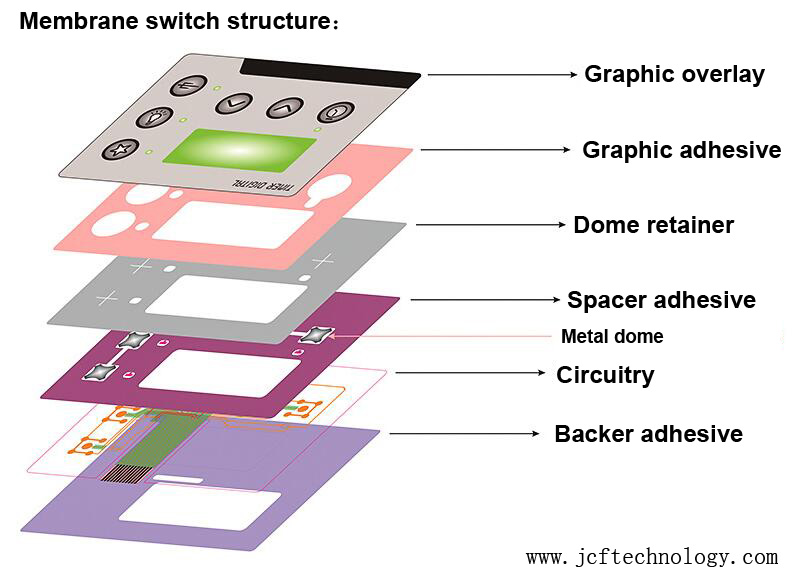Membrane Switch: Reliable, Cost-Effective, and User-Friendly Control Systems
Membrane Switch: Reliable, Cost-Effective, and User-Friendly Control Systems
Blog Article
Comprehending Membrane Layer Changes: The Secret to Sturdy and Dependable Controls

What Are Membrane Layer Buttons?
Membrane layer buttons are an innovative remedy in the world of interface modern technology, integrating functionality and layout flawlessly. These gadgets work as an interface between individuals and electronic systems, integrating several parts right into a portable layout. Generally built from flexible, thin layers of products, membrane switches are developed to reply to touch, enabling users to communicate with equipment and electronic gadgets successfully.
The primary aspects of a membrane switch include a published circuit layer, graphic overlay, and a spacer layer that protects against unintentional activation. The graphic overlay can be tailored to mirror brand name identity or customer preferences, enhancing appearances while guaranteeing usability. Membrane layer buttons are typically utilized in different applications, including clinical gadgets, consumer electronic devices, and commercial equipment, owing to their longevity and resistance to environmental factors such as moisture and dirt.
Among the crucial benefits of membrane buttons is their ability to endure deterioration, making them ideal for high-traffic environments. In addition, they are light-weight and need marginal space, permitting innovative designs in item development. In general, membrane switches over represent a reliable and useful selection for modern electronic interfaces, marrying innovation with user-centric style principles.
Exactly How Membrane Switches Over Job
The operation of membrane layer switches over hinges on an easy yet effective device that equates customer input right into digital signals. When an individual presses the switch, the leading layer warps, allowing a conductive aspect in the circuit layer to make call with an equivalent conductive pad on the bottom of the graphic overlay.
The design of membrane switches can differ, however they commonly incorporate domes or tactile components to give comments to the individual, boosting the total experience - membrane switch. The materials made use of in membrane buttons, such as polyester or polycarbonate, add to their resilience and resistance to ecological aspects, including moisture and dust. The printed circuits are commonly enveloped, which secures them from wear and tear over time.
Advantages of Membrane Switches

Additionally, membrane layer buttons are known for their resilience. Built from durable materials, they are resistant to dirt, moisture, and physical wear, which significantly expands their life-span contrasted to conventional mechanical switches. This durability makes them specifically suitable for high-traffic settings and applications calling for long life.
An additional substantial advantage is the simplicity of cleansing and maintenance. The smooth surface of membrane layer changes reduces dirt buildup and is frequently invulnerable to spills, making them perfect for setups that call for constant sanitization.
In addition, membrane layer switches provide a structured profile, bring about a thinner layout that can be incorporated into numerous tools without adding bulk. This feature not only improves the aesthetic allure but also adds to an extra ergonomic item layout.
Applications of Membrane Layer Buttons
User-friendly and versatile, membrane layer switches locate applications across a useful reference large range of industries, including clinical devices, customer electronics, and industrial devices. In the clinical field, these buttons are indispensable to tools such as diagnostic equipment, individual tracking systems, and infusion pumps, where dependability and convenience of cleaning are critical. Their ability to stand up to harsh settings and maintain performance makes them optimal for such applications.

In consumer electronic devices, membrane switches are utilized in items like microwaves, washing devices, and push-button controls - membrane switch. Their sleek browse around here design permits instinctive user interfaces, enhancing the overall user experience while offering resilience and resistance to tear and use
Commercial tools also takes advantage of membrane layer buttons, specifically in control panels for equipment and automation systems. These switches use security against dust and dampness, ensuring consistent efficiency in tough environments. Their customizable features permit producers to customize them to specific operational needs, enhancing performance and performance.
Choosing the Right Membrane Switch
When choosing a membrane switch, it is vital to think about different factors that affect efficiency and viability for particular applications. The main considerations consist of ecological conditions, tactile feedback, durability, and design specs.
First, evaluate the operating atmosphere; switches subjected to dampness, chemicals, or severe temperatures need details materials to make sure durability and functionality. Next off, evaluate the demand for tactile feedback. Depending on user communication, some applications might gain from a tactile action to verify activation, while others might choose a non-tactile style for visual factors.
Longevity is one more important variable; membrane layer buttons must be designed to hold up against regular use, influences, and abrasion. Make sure the chosen switch can sustain the expected lifecycle, particularly in high-usage situations.

Verdict
In conclusion, membrane switches over informative post offer as vital parts in the design of sturdy and trustworthy control systems throughout numerous industries. The flexibility of membrane switches over allows for tailored options that fulfill details operational needs, strengthening their value in modern-day technology.
Membrane switches represent an essential facet of modern interface design, blending functionality with durability in different applications.Membrane layer buttons are an advanced option in the world of customer interface modern technology, incorporating capability and layout seamlessly. Generally constructed from flexible, thin layers of materials, membrane layer buttons are made to react to touch, making it possible for customers to connect with equipment and digital tools successfully.
The style of membrane switches can vary, yet they often incorporate domes or responsive aspects to supply comments to the individual, enhancing the total experience.In verdict, membrane layer changes serve as essential components in the layout of trustworthy and long lasting control systems across numerous sectors.
Report this page